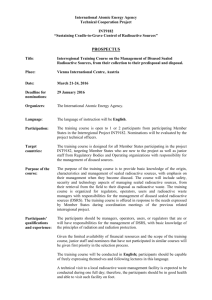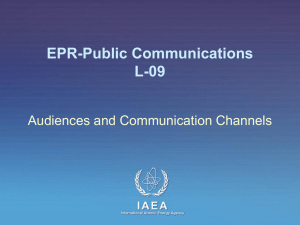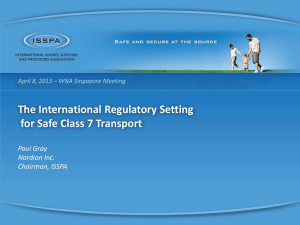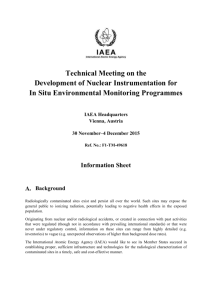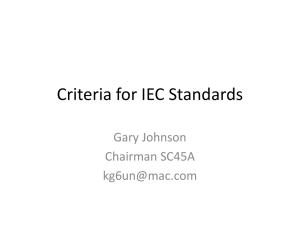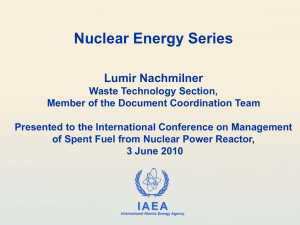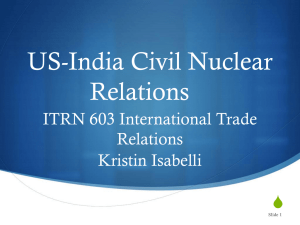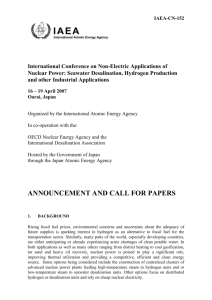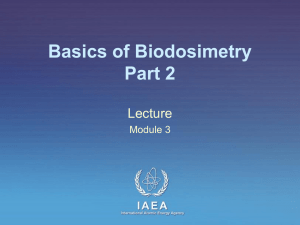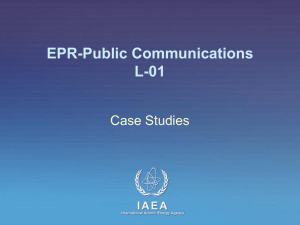P. Colgan - Publications - International Atomic Energy Agency
advertisement
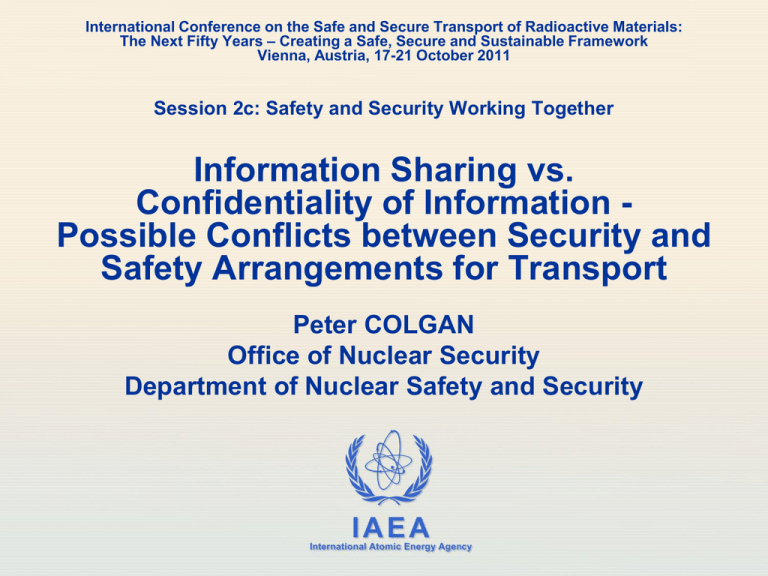
International Conference on the Safe and Secure Transport of Radioactive Materials: The Next Fifty Years – Creating a Safe, Secure and Sustainable Framework Vienna, Austria, 17-21 October 2011 Session 2c: Safety and Security Working Together Information Sharing vs. Confidentiality of Information Possible Conflicts between Security and Safety Arrangements for Transport Peter COLGAN Office of Nuclear Security Department of Nuclear Safety and Security IAEA International Atomic Energy Agency Introduction Safety and Security Transport Regulations developed apart • Safety (1950s) for all classes of dangerous goods • Developed under the auspices of ECOSOC (UNECE Secretariat) and IAEA • Harmonization to avoid burden at borders • Standardization of requirements • Package testing and level of performance, • Documentation including labels (diamond form), marking, placarding and transport documents • Applicable to ALL shipments UN 2915 IAEA 2 Introduction Safety and Security Transport Regulations developed apart • Security • Against theft of nuclear material (1970s) (INFCIRC/225, Rev1 and CPPNM) • Against sabotage, for recovery of nuclear material (2000s) • CPPNM (2005 Amendment) • NSS-13 (INFCIRC/225, Rev5) General provisions for transport categories (TA) • Security plans for other radioactive material (2000s) (NSS-14) • Completed by NSS-09 for Transport Security Security plans and security levels • and NSS-11 for Radioactive Sources IAEA 3 Introduction Safety and security • Nuclear safety - Protect people and environment from harmful radiation exposure (accidents by inadvertent human error, equipment failure, natural events...) • Nuclear Security – Prevention of, and response to, malicious acts by non-State actors • Common purpose • Preventing a large release of radioactive material / Limiting radiation exposure • Most requirements enhance both safety and security • Existence of conflicting requirements? • Safety Fundamentals requirement • SF-1 para. 1.10 “Safety measures and security measures must be designed and implemented in an integrated manner so that security measures do not compromise safety and safety IAEA measures do not compromise security.” 4 A consistent Regulatory framework for Transport Safety and Security? NSS-14 (NSS-09, NSS-11) Radioactive Material All modes Radioactive material All modes NSS-13 . (through CPPNM) . IAEA Nuclear Material All modes Three examples of conflicting requirements: 1/ Thresholds for Excepted Packages 2/ Information Management 3/ Confined Transport 1/ Thresholds for Excepted Packages Safety Background • Radioactive Material (Basic radionuclide values) • Based on Q-system (A1/A2 values), developed in the 1970s • Graded approach and different levels of performance (package / material designs) • Standardized package testing (in line with UN) • ‘Safety is in the Package’ IAEA 6 1/ Thresholds for Excepted Packages Security Background • Security levels for nuclear material Transport categories (I, II, III) based on CPPNM, and also Potential radiological consequences (NSS-13) • Security levels for other radioactive material High consequences radioactive material (NSS-09) - 10xD (for 25 radionuclides listed in the Code of Conduct) - 3000 A2 for all other radionuclides • D-values Basis for categorization of radioactive sources (RS-G-1.9) Specific scenarios (EPR-2006) (“Pocket” and “Room” scenarios) Reassess validation / applicability of D-values for transport security scenarios A-values v’s D-values: are they consistent and are the scenarios relevant to security? IAEA 7 1/ Thresholds for excepted packages Security Background • New Security provisions, in force as of 1st Jan, 2013 Two security levels are recommended Incremental Transport Security Measures * * Excepted packages with activity not exceeding the level permitted for the radionuclide when it is not in special form IAEA * Some small risk shipments fall below the lesser of the two levels of security For radioactive materials posing a minimal threat, only prudent management practices are 8 necessary 1/ Thresholds for Excepted Packages Identified conflict • Excepted packages may carry high consequence dangerous goods (radioactive) – and require a security plan? • For Am241, A1 = 167*D • For Am241, 10*D = 600 GBq Possible solution • Revise Excepted Packages Thresholds so that no security plan needed OR • Revise Precedence of classes for Excepted Packages (UN) 241Am IAEA low energy gamma source (QSA-Global) 0.37 to 74 GBq Excepted package 9 2/ Information Management Safety Background • Open information On consignment: labels (diamond form), marking, placarding With the carrier: transport documents, written instructions Local authorities: Notification On website (not mandatory): Occurrences of transport (Local authorities) • Sharing information All information available and shared before shipment - Transport with set of validated data Information available on safety issues on request (transparency policy) • Immediate availability of information - For emergency response (identification / recovery of packages)` IAEA - Precaution Principle 10 2/ Information Management Security Background • Limiting advanced knowledge (even for Coastal State) to a minimum number of persons • Importance of: - preliminary information / communication prior to shipments (via other channels with Coastal States authorities) = Public acceptance - preparation (security issues related to physical protection) • Escort and guards accompanying shipment • Continuity of (restricted) information circulation during transport (follow-up and status) IAEA 11 2/ Information management Identified conflict • Does an escorted shipment need visible identification? Solution pathway • Manage contradictory requirement by integrated safety-security approach • Endorse security requirement as “equivalent” safety requirement IAEA 12 3/ Confined transport Safety Background • Nuclear material with high residual heat • Thermal analysis for package design (TS-R-1) • Standardized environmental conditions (38°C, insolation) • Feature added to the package (not to reduce safety) (para. 611) • Special stowage provisions for the safe dissipation of heat (para. 552a) IAEA 13 3/ Confined transport • Security Background • Presence of physical protection for nuclear material (e.g. armored container or thermal barrier (< 85°C)) IAEA 14 3/ Confined transport • Identified conflict • Package safety may be altered by physical protection • Safety issue for evacuation of calories - Limitation of heat power (factor ~2) • Safety issue: Qualification of the complete conveyance by thermal analysis IAEA 15 Conclusions Ways to have an integrated elaboration of safety-security requirements • SF-1 1.10 “Safety measures and security measures must be designed and implemented in an integrated manner so that security measures do not compromise safety and safety measures do not compromise security.” 1/ First undertake a dual appraisal for safety and security requirements • No precedence of safety/security requirements • Integrated approach with feedback • Same approach with other dangerous goods 2/ Periodic dual appraisal for safety and security requirements IAEA 16 Thank You for Your Attention IAEA 17
